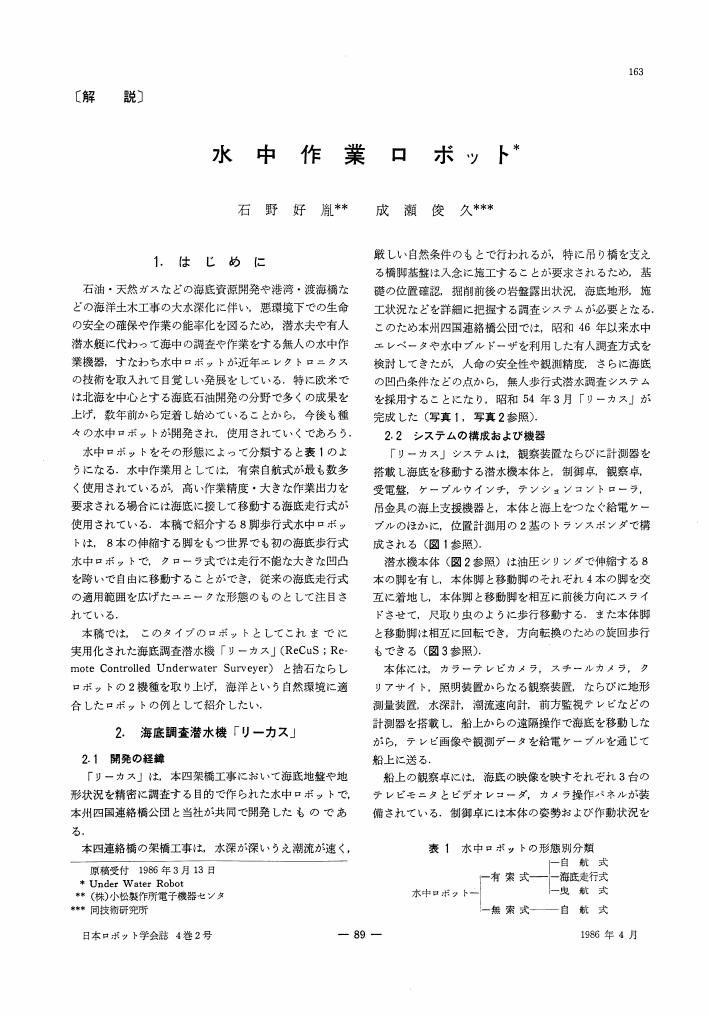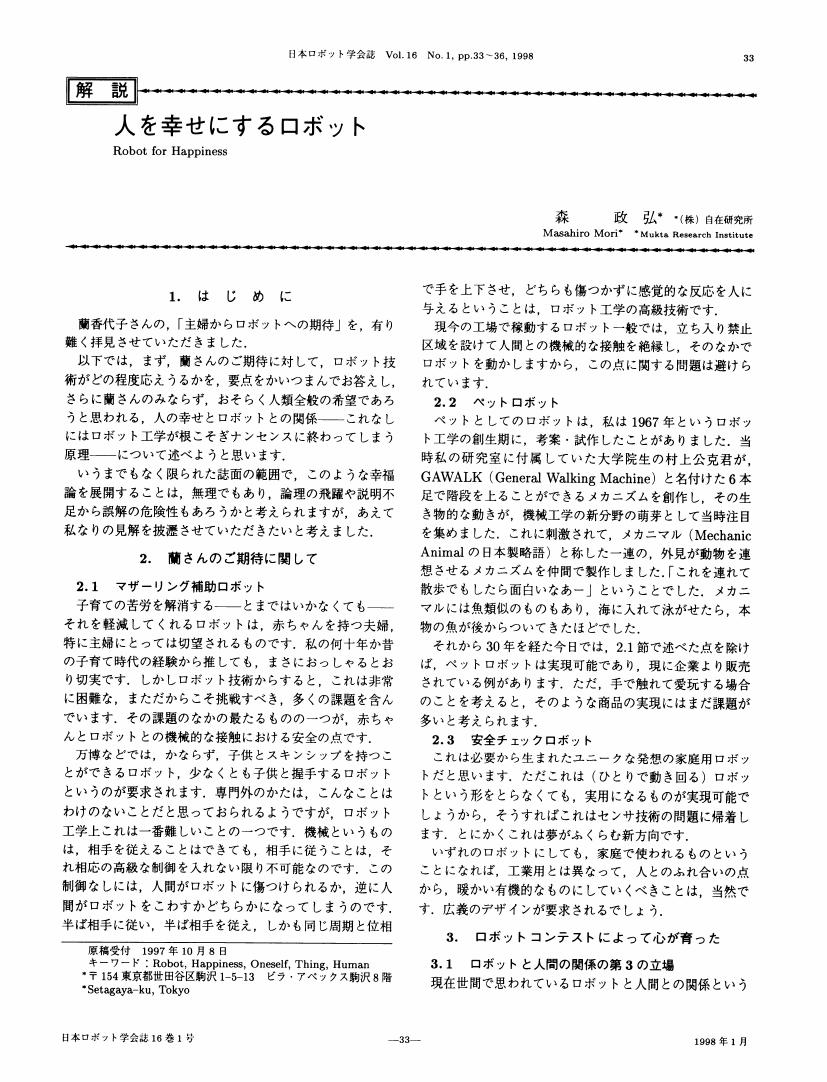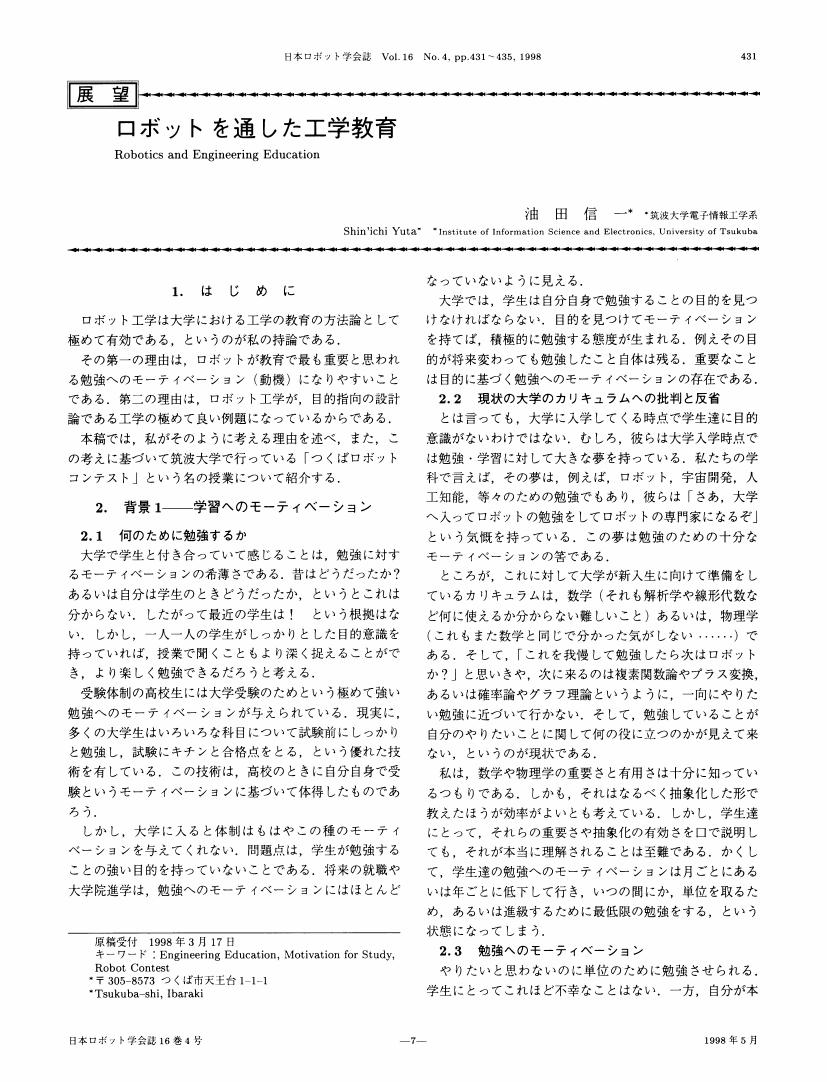62 0 0 0 OA 水中作業ロボット
- 著者
- 石野 好胤 成瀬 俊久
- 出版者
- The Robotics Society of Japan
- 雑誌
- 日本ロボット学会誌 (ISSN:02891824)
- 巻号頁・発行日
- vol.4, no.2, pp.163-170, 1986-04-15 (Released:2010-08-25)
45 0 0 0 OA 開拓者精神を燃やし続けて
- 著者
- 浅田 春比古
- 出版者
- The Robotics Society of Japan
- 雑誌
- 日本ロボット学会誌 (ISSN:02891824)
- 巻号頁・発行日
- vol.23, no.8, pp.930-933, 2005-11-15 (Released:2010-08-25)
27 0 0 0 OA 猫ひねり動作の解明とロボットによる猫ひねりの実現
- 著者
- 山藤 和男 小林 剛 河村 隆
- 出版者
- The Robotics Society of Japan
- 雑誌
- 日本ロボット学会誌 (ISSN:02891824)
- 巻号頁・発行日
- vol.10, no.5, pp.648-654, 1992-09-15 (Released:2010-08-25)
- 参考文献数
- 10
- 被引用文献数
- 4 11
Postural control of a falling cat was investigated analytically and experimentally. The authors intended to develop such a robot as a cat that could restore her attitude at free fall by twisting and controlling the body. There are still contradictory and ambiguous explanations among the text books of physics or dynamics which deal twisting motion of a cat. Firstly, the principle of the twisting motion of a robot cat was analysed using a jointed double column model. And it was made clear analytically that a cat could restore her attitude by bending and twisting the body in the air. Then, the authors developed the robot cat which had vertebrate-type backbones and twisting mechanisms. It was confirmed experimentally that the robot cat could control its attitude by 180 degrees' rotation within 0.6 second when it was released upside-down at about 1.8m height in the air.
24 0 0 0 ペット型ロボットの感性表現
- 著者
- 藤田 雅博
- 出版者
- The Robotics Society of Japan
- 雑誌
- 日本ロボット学会誌 (ISSN:02891824)
- 巻号頁・発行日
- vol.17, no.7, pp.947-951, 1999-10-15
- 被引用文献数
- 11 19
23 0 0 0 OA SFのロボットを科学する
- 出版者
- The Robotics Society of Japan
- 雑誌
- Journal of the Robotics Society of Japan (ISSN:18847145)
- 巻号頁・発行日
- vol.12, no.3, pp.368-388, 1994-04-15 (Released:2010-08-25)
19 0 0 0 OA 二重振り子とカオス
- 著者
- 小室 元政
- 出版者
- The Robotics Society of Japan
- 雑誌
- 日本ロボット学会誌 (ISSN:02891824)
- 巻号頁・発行日
- vol.15, no.8, pp.1104-1109, 1997-11-15 (Released:2010-08-25)
- 参考文献数
- 4
- 被引用文献数
- 1
17 0 0 0 OA 人を幸せにするロボット
- 著者
- 森 政弘
- 出版者
- The Robotics Society of Japan
- 雑誌
- 日本ロボット学会誌 (ISSN:02891824)
- 巻号頁・発行日
- vol.16, no.1, pp.33-36, 1998-01-15 (Released:2010-08-25)
- 参考文献数
- 3
- 被引用文献数
- 1
12 0 0 0 OA 6自由度マニピュレータの特異点適合遠隔操作
- 著者
- 妻木 勇一 小寺 真司 ネンチェフ D.N. 内山 勝
- 出版者
- The Robotics Society of Japan
- 雑誌
- 日本ロボット学会誌 (ISSN:02891824)
- 巻号頁・発行日
- vol.16, no.2, pp.195-204, 1998-03-15 (Released:2010-08-25)
- 参考文献数
- 19
- 被引用文献数
- 1
In our previous work we proposed two approaches to singularity treatment: one is based on a null space notation, and the other on an adjoint Jacobian. We call these approaches as the singularity-consistent approach. Both meth-ods guarantee the direction of motion in the whole work space, without producing an infeasible joint velocity. The performance has been experimentally verified with 3-DOF manipulators. In this paper, we apply the method to a real telerobot system with a non-redundant 6-DOF manipulator as the slave. We analyze the velocity relation at the singularities of this manipulator, and discuss several important implementation issues. The experimental results show that the 6-DOF manipulator can be operated safely with feasible joint velocity and without any error in the direction of motion.
12 0 0 0 OA 反射の組み合わせによる歩行の実現
- 著者
- 宮下 敬宏 細田 耕 竹内 進 浅田 稔
- 出版者
- The Robotics Society of Japan
- 雑誌
- 日本ロボット学会誌 (ISSN:02891824)
- 巻号頁・発行日
- vol.18, no.3, pp.381-386, 2000-04-15 (Released:2010-08-25)
- 参考文献数
- 11
- 被引用文献数
- 1
This paper presents a reflective walk of a quadruped robot based on reflections to realize an adaptive walk in a dynamic environment. The combination of reflections, a vision-cued swaying reflection [1] and a reflective gait, makes the robot walk reflectively, without programming the exact motion of each joint of the legs. An experiment is shown to demonstrate how the proposed method works.
12 0 0 0 それでもスーパーロボットは動くのだ
- 著者
- 金岡 克弥
- 出版者
- The Robotics Society of Japan
- 雑誌
- 日本ロボット学会誌 (ISSN:02891824)
- 巻号頁・発行日
- vol.29, no.2, pp.140-143, 2011-02-20
11 0 0 0 OA 唯脳論
- 著者
- 養老 孟司
- 出版者
- The Robotics Society of Japan
- 雑誌
- 日本ロボット学会誌 (ISSN:02891824)
- 巻号頁・発行日
- vol.7, no.5, pp.528-534, 1989-10-15 (Released:2010-08-10)
10 0 0 0 OA How to Make a Conscious Robot
- 著者
- Takashi Maeno
- 出版者
- The Robotics Society of Japan
- 雑誌
- Journal of the Robotics Society of Japan (ISSN:02891824)
- 巻号頁・発行日
- vol.23, no.1, pp.51-62, 2005-01-15 (Released:2010-08-25)
- 参考文献数
- 32
- 被引用文献数
- 3 10 13
A fundamental idea for constructing a conscious robot is presented. First, hypotheses of the human mind are presented. The following ideas are shown: (1) The unconscious system is a recurrent network system made of various distributed subsystems. (2) Information of the mind such as intellect, feelings and willpower, is presumably processed in the unconscious system instead of the conscious system. (3) The conscious system just monitors, experiences afterward, models and memorizes the results of the unconscious system. (4) Realistic experiences of quality that the conscious system feels by itself are just illusions that are defined in the brain. Then an algorithm of a robot mind is constructed based on the hypotheses mentioned above. It is shown that a conscious mind of robots can be made using the proposed algorithm. Finally, purposes and issues of the robots with a mind are also discussed.
9 0 0 0 OA 自律型海中ロボット
- 著者
- 浦 環
- 出版者
- The Robotics Society of Japan
- 雑誌
- 日本ロボット学会誌 (ISSN:02891824)
- 巻号頁・発行日
- vol.18, no.7, pp.933-936, 2000-10-15 (Released:2010-08-25)
- 参考文献数
- 7
- 被引用文献数
- 5 6
9 0 0 0 OA 倒立振子から始めた動的2脚ロボットの開発
- 著者
- 江村 超 玄 相昊
- 出版者
- The Robotics Society of Japan
- 雑誌
- 日本ロボット学会誌 (ISSN:02891824)
- 巻号頁・発行日
- vol.23, no.4, pp.418-421, 2005-05-15 (Released:2010-08-25)
- 参考文献数
- 9
7 0 0 0 OA ロボットを通した工学教育
- 著者
- 油田 信一
- 出版者
- The Robotics Society of Japan
- 雑誌
- 日本ロボット学会誌 (ISSN:02891824)
- 巻号頁・発行日
- vol.16, no.4, pp.431-435, 1998-05-15 (Released:2010-08-25)
- 被引用文献数
- 1
7 0 0 0 OA 自律的帰還機能を持つ荷物運搬用電動台車の開発
- 著者
- 三澤 正志 吉田 智章 油田 信一
- 出版者
- The Robotics Society of Japan
- 雑誌
- 日本ロボット学会誌 (ISSN:02891824)
- 巻号頁・発行日
- vol.25, no.8, pp.1199-1206, 2007-11-15 (Released:2010-08-25)
- 参考文献数
- 9
- 被引用文献数
- 1 6
We developed a smart handcart with autonomous returning function. In the conventional handcarts to carry baggage, a user pushes a handcart with baggages on the way to destination, and then, he also should carry it back without load. The developed handcart is equipped with odometry function and a laser range scanner. It records its trajectory and surrounding environment while going to destination, and it can autonomously return back to the station by retracing the recorded trajectory and environmental information. As feature of the environment to compensate the accumulating error in odometry, the cart uses flat wall and edge of pillar which is extracted by its laser range scanner. Experimental results shows the effectiveness and reliability of the system.
7 0 0 0 OA 車輪式移動ロボットの運動学および動力学の一般理論に関する研究
- 著者
- 築島 隆尋 高野 政晴 佐々木 健 井上 健司
- 出版者
- The Robotics Society of Japan
- 雑誌
- 日本ロボット学会誌 (ISSN:02891824)
- 巻号頁・発行日
- vol.8, no.6, pp.699-711, 1990-12-15 (Released:2010-08-25)
- 参考文献数
- 11
- 被引用文献数
- 4 9
This paper proposes a general theory for kinematics and dynamics of wheeled mobile robots (WMRs) . This study has two features: 1) The proposed method can deal with various WMR system ranging from typical three or four-wheeled mobile robot to multi-WMR systems where multiple WMRs are connected by joints. A WMR is regarded as a planar linkage mechanism with several ends: wheels correspond to the ends. Generally, a WMR system has active joints such as steering axis, passive joints such as casters and couplers, and driven/non-driven wheels. A model of WMR system called tree structure link covering these configurations is proposed. 2) This theory deals with kinematics and dynamics of WMR including slip of wheels. WMR dynamics is derived regarding frictional force between wheels and the ground as an external force which is a function of the slip speed. When no slip is assumed in wheels, WMR's motion is expressed by kinematics. In this manner, the proposed method is applied systematically on the kinematics when slip can be neglected and the dynamics when slip exists. Furthermore, velocity input dynamics is proposed which gives the motion of WMR when the velocity commands are inputs to active joints and wheels under the condition that wheels slip.
7 0 0 0 OA ZMPを安定規範とした2足歩行ロボットの上体補償運動の学習制御
- 著者
- 李 清華 高西 淳夫 加藤 一郎
- 出版者
- The Robotics Society of Japan
- 雑誌
- 日本ロボット学会誌 (ISSN:02891824)
- 巻号頁・発行日
- vol.11, no.4, pp.557-563, 1993-05-15 (Released:2010-08-25)
- 参考文献数
- 12
- 被引用文献数
- 2 5
The authors have been using the ZMP (Zero Moment Point) as a criterion to distinguish the stability of walking for a biped walking robot that has a trunk. In this paper, the authors propose a learning control algorithm of the compensative trunk motion that makes the actual ZMP get closer to the desired ZMP. The convergency of the algorithm is confirmed by computer simulation. By the learning experiments with the biped robot, the reappearance of the measured ZMP is shown and the convergency of the algorithm is confirmed. The change of the convergence rate with the change of the weight coefficient multiplied to the errors between the measured ZMP and the disired ZMP is confirmed by the simulation and the experiments. And also the reasons are discussed.
6 0 0 0 OA サキソフォンとトランペットの自動演奏ロボットについて
- 著者
- 高島 俊
- 出版者
- The Robotics Society of Japan
- 雑誌
- 日本ロボット学会誌 (ISSN:02891824)
- 巻号頁・発行日
- vol.14, no.2, pp.196-199, 1996-03-15 (Released:2010-08-10)
- 参考文献数
- 6
6 0 0 0 OA 道具を使う手と脳の働き
- 著者
- 入來 篤史
- 出版者
- The Robotics Society of Japan
- 雑誌
- 日本ロボット学会誌 (ISSN:02891824)
- 巻号頁・発行日
- vol.18, no.6, pp.786-791, 2000-09-15 (Released:2010-08-25)
- 参考文献数
- 13









